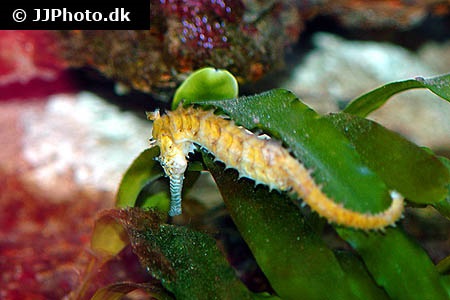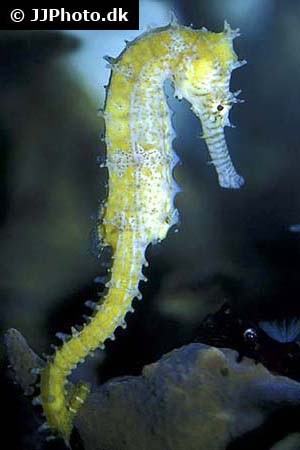Hippocampus coronatus


| Latin name | Hippocampus coronatus |
|---|---|
| Local name | Crowned seahorse |
| Family | Syngnathidae - Hippocampus |
| Origin | Japan |
| Max length | 11 cm (4.3") |
| Minimum volume |
100 l (26 gal) |
|---|---|
| Hardiness |
Average |
| Suitable for aquarium |
Suitable for special aquariums |
| Reef safe |
Always reef safe |
| Aggressiveness | Peaceful |
| Recommended |
Small crustaceans (Krill, mysis, artemia...) Zooplankton (Cyclops, pods...) |
|---|
This species often becomes malnourished in captivity, it is therefore important to enrich their food with omega-3 and vitamins.
Species of the Pipefish family should be kept in a dedicated tank, see the family description below.
Seahorses/Pipefishes will normally only accept live feed. Live Mysis or Artemia are particularly well suited.
Captivity bred Seahorses however, may have learned to eat frozen Mysis from the beginning and are therefore much easier to keep.
This species thrives best as a pair or in a small group.
This species can be bred in captivity, one can therefore consider asking your local fish store for a captive bred specimen.
While Pipefishes/Seahorses (Syngathidae) are fascinating because of their unique appearance and way of moving, they are definitely not suitable for all aquaria.
Its important to arrange the aquarium so the Pipefishes/Seahorses has something to latch onto with its tail. This could be kelp, macro algae or similar, but this must not include corals or anemones as these might burn the Pipefish/Seahorse.
The water current must not be too powerful, as they are not strong swimmers. Pipefish can however, handle a slightly more powerful circulation than seahorses.
One should avoid keeping seahorses together with food competitors as this will impede feeding.
Aggressive species, predatory fish, crabs, lobsters and such should be avoided too, as they will damage or eat the Seahorses.
The easiest solution is to keep them in a small aquarium, down to 40 liters is perfect for a little group, as a confined space makes it easier to control feeding.
The filter system must be able to handle frequent feeding with frozen food.
Seahorses and pipefish are not particularly sensitive towards the quality of the water, but do require, like most fish, that the aquarium is properly maintained.
If one wishes to keep pipefishes in a coral aquarium, the Flagtail Pipefish (the Doryhamphus and Dunckerocampus genus) is an option, although it can be challenging to feed them and the other fish and invertebrates in the aquarium must be chosen carefully.
Seahorses are on of the few fish bred for the aquarium trade, as well as being endangered in the wild. Luckily they are bred in captivity in multiple places. Captive bred specimens are often easier to feed, which is a big advantage.
If the fish are not captive bred, it may be necessary to feed with live food to start with.
Pipefish are not so widely bred as seahorses.
To ensure continual nourishment, add omega-3 and vitamins to their frozen food, or feed them live Artemia which themselves have received nutritious food.
Pipefish/Seahorses do not have a long life expectancy, generally 2-3 years.
Seahorse.org - (English)
Henry C. Schultz. 2003. There's More to Pipes Than Just PVC: The Genus Doryrhamphus and Other Pipefish - Reefkeeping Magazine - (English)
Scott W. Michael. 2001. Reef Fishes volume 1 - TFH Publications / Microcosm Ltd. - (English)
Beth Panocha. 2004. Aquarium Fish: Seahorse Care: A Basic Guide To Starting Your First Herd - Advanced Aquarist - (English)
Pete Giwojna. 2007. A Seahorse Reef Part 1: Reef Compatibility of Hippocampus spp. - Tropical Fish Hobbyist - (English)
Pete Giwojna. 2007. A Seahorse Reef, Part Two: Choosing Your Seahorses - Tropical Fish Hobbyist - (English)

